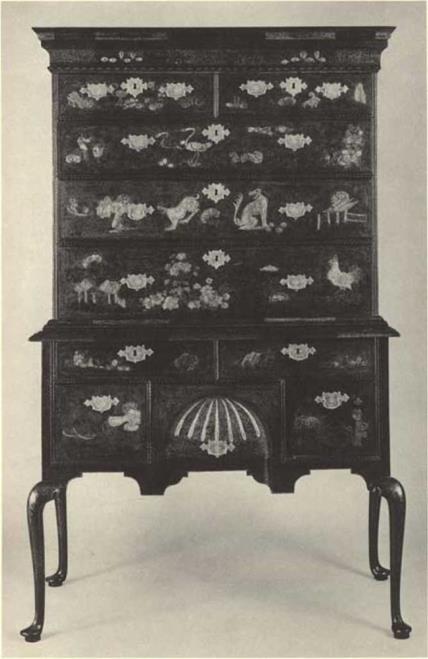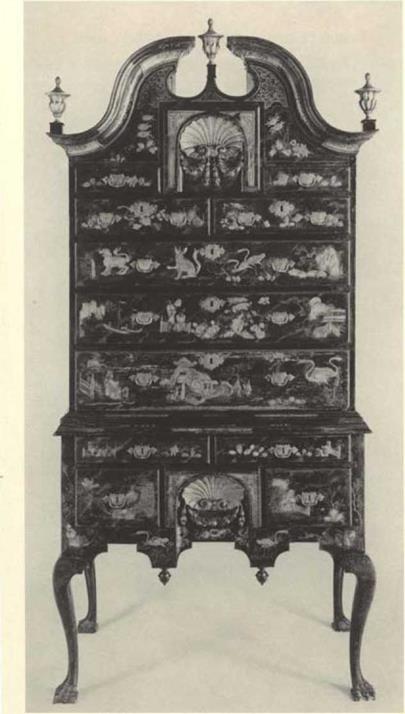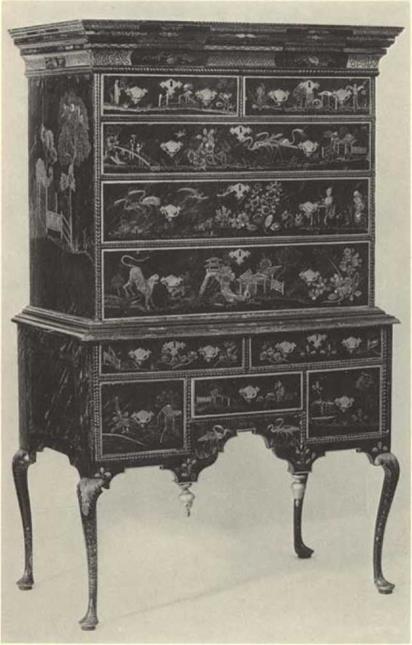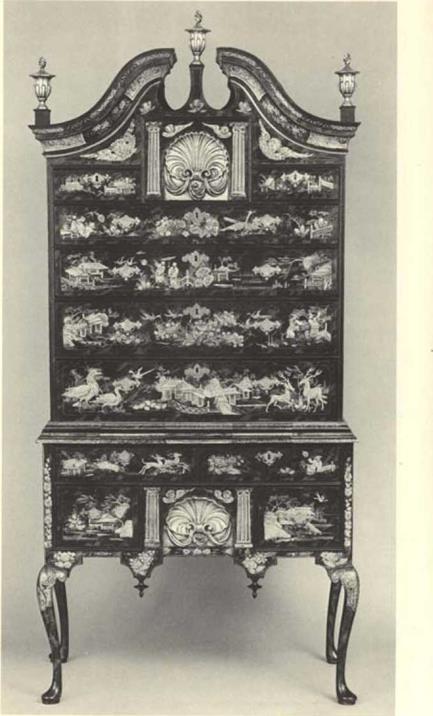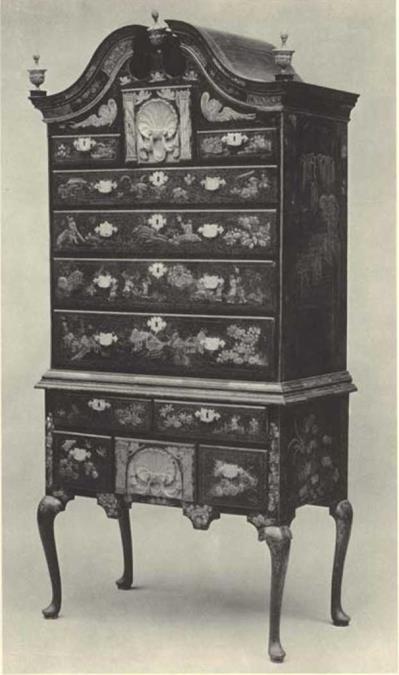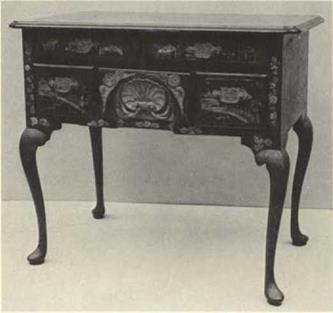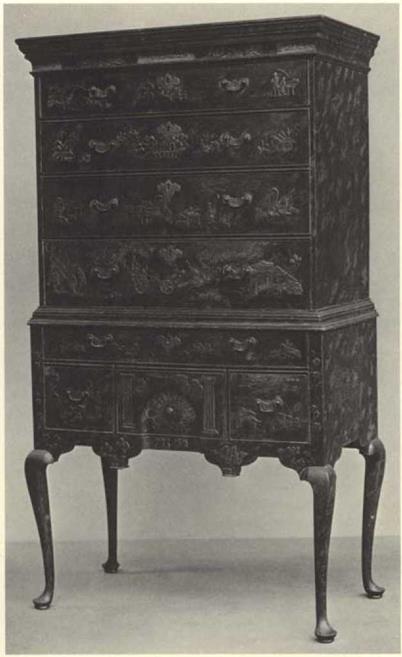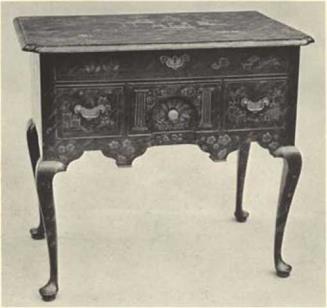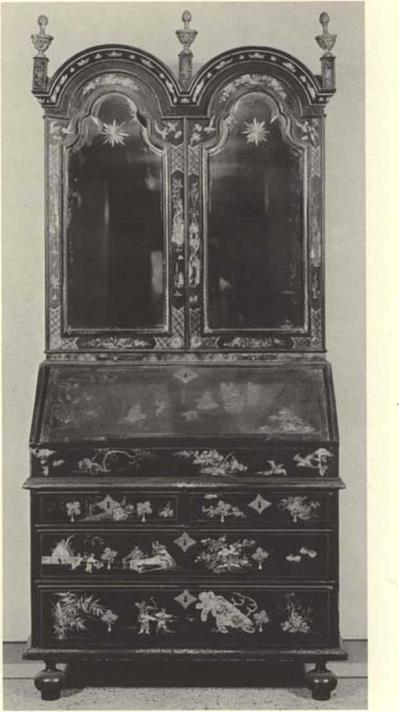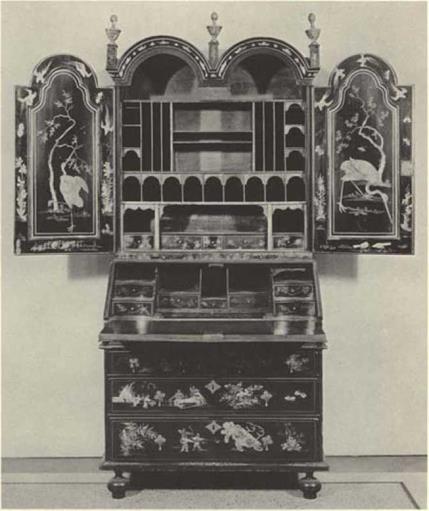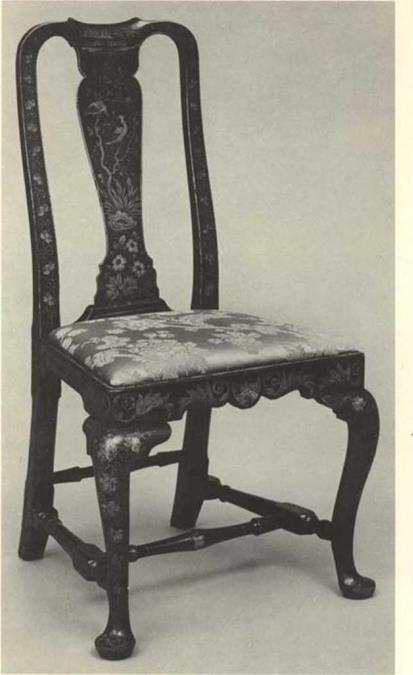who advertised in The Button News-Letter of April 25 – May 2, 1715; “ Looki ng-G lasses of all sorts. Glass Sconces, Cabbinctts Esc г u to ires Chcsts4>f*Dnweis, Tables, Beaufetts, Writing Desks, Bookcases with Desks, old Glasses new Silvered, and all sons of Japan-work, Done and Sold by M rilllam Randle at the Sign of the Cabbinett, a Looking – Glass Shop in Queen-Street near the Town-House Boston.” The Adams high chest has much of its original raised w ork on the drawers hut contains some nineteenth-century overpain ring on the moldings and legs. The large, prominent figures are not unlike those on other William and Mary high chests (fig, 44) or the Queen Anne high chest (fig. 35) signed by Robert Davis, another Boston j ара liner.
The Davis high chest, the third documented example of Boston japanning, is a flat-topped high chest of about 173 j with cabriole legs and pad feet in the collection of the Baltimore Museum of Art. s Unfortunately, ihe ravages of neglect and proximity ro a fire have relieved the piece of all qf its minor flat decoration, and only parts of its major scenes remain. The thrce-lobed plants, figures, and animals tic in with the vocabulary of other j spanners; their boldness and larger scale are representative of the earlier Boston work before the 1740s. Another high chest that can be linked to Robert Davis, with similar decoration and even cabinet making details, was shown in Antiques, lxv (February, 1954), 103, and is nowr in the collection of the Shelburne Museum.
The other candidates arc two tall case clocks by Gawcn Brown, the japanning of which can be linked to Thomas Johnston by circumstantial evidence. The first, a magnificent example at Winterthur (fig. 36), is in all early style. Brown came to Boston in 1748. and one ofh is earliest advertisements in The Boston Evening-Post (January 16. 1749) stated: "That Gawcn Brdien, Clock and Watch Maker lately from London, keeps his Shop at Mr. Johnson’s, Japan nor. in Brailie-
5. Two signature! appear an line of the drawer divider* in the upper nectiiMi. The fcjUltrd one is "Rubcrl Djvis" and the other, in smaller script, appears to be "Re. Dniiiiii." "IT 1 r Li til ills "W it," possibly those oi William Randle, another Boston I jpjiiiiiT, alto appear on a drawer of the chest – This information was kindly provided by Block Jobe. See Elizabeth Rhoades and Brock Jobe. "Recent Discoveries in Boston Japanned Furniture.” /blifiin, CV (May. 1974), 1ОЇІ-ІО91,
|
|
35. Ниш Снеїї. Japanned by Robert Davis, Boston, c. 17;5-17^51, Maple and white pinei H. <58 у, inches, Sv, 4”’ * niches, D. iz% inches. (The Baltimore Museum oi’An.)
 36- Tall Clock. Works by Gawen Brown, japanning attributed Co Thomas Johnston, Boston, c. 1749- White pioe; ir 94’/* inches, w, 2il/4 inches, i>, 10% inches. {The Henry Francis du Pont Winterthur Museum.)
36- Tall Clock. Works by Gawen Brown, japanning attributed Co Thomas Johnston, Boston, c. 1749- White pioe; ir 94’/* inches, w, 2il/4 inches, i>, 10% inches. {The Henry Francis du Pont Winterthur Museum.)
Street, Boston, near Mr. Coopers Meeting House, where he makes and sells all sorts of plain, repeating and astronomical Clocks, with Cases, plain, black Walnut, Mahogony or Japann’d.”[30]
From this, it would appear that Johnston can he considered the japanner of the clock. The buildings, bridge, sultan, and equestrian figure do not appear with any real similarities on any Boston high chests, which have their own formulas for decoration. 1 lowcvcr, these clock motifs do appear in identical fashion On a rather disheveled case on another Gawcn Brown clock at the Henry Ford Museum.[31] [32] These are die only two pieces of Boston japanning I have been able to find with identical decoration throughout. Due to his importance, Johnston has been associated with other japanned pieces. The great high chest at Winterthur (fig. 37) made by the cabinetmaker John Pimm for Commodore Joshua Loring, probably the summit of American japanning, has been linked to Johnston without foundation.3 It was undoubtedly japanned by the same unidentified person as the fmc high chest at the Museum of Fine Arts, Boston, notable for the excellent condition of its decoration (fig. j&).
The 1732 Johnston trade card has also provided ovcroptimistic opportunities for attributions. The dropped finials of a flat-topped high chest at Winterthur (Downs, American Furniture, no, 187) have been likened to those on the trade card. Another group consists of two high chests with broken-arch tops at Bayou Bend (fig. 39) and the Metropolitan Museum of Art (fig. 40). both of which have cherubs in their upper sccrions. Cherubs also appear on the sign in Johnston’s trade card. Unfortunately cherubic and finialistic hopes
|
|
37. Hick Chest. Made by John Pimm, JJosion, c, 1740-1730, Mapte and while pine; h. inches, w. 40 inches, I). Hl/l inches. (The Henry Francis dn Pour Winterthur Museum.) Affording to family tradition, this that was owned by Joshua Loring (і;ій-і7Їг) of Jantaita Plain and Bosloti,
|
|
38. High CntsT. Boston area, c. 1725-1740. Maple 2nd svhite pine; H, 71 % inches, w. 427inches, n. 24% inches. [Museum of Fine Arts, Boston, Bequest of Charles Hitchcock Tyler, 52.127,) do not make firm attributions, and these two high elicsts, one with a matching dressing table (fig. 41) and all with similar decoration to another marching flat-topped high chest and dressing table (figs. 42 and 43), must remain in the limbo of anonymity until more persuasive testimony is offered.
Other examples of Boston japanning include a six-legged William and Marr high chest with bold figures on a black ground at the Metropolitan Museum (fig. 44) and two similar six-lcggers with more intricate decorat ton* one at Winterthur (much of its decoration gone), and one at Historic Deerfield, Inc. (fig. 43). Most of the earlier examples (to the 1730s} have black backgrounds, while the tortoiseshell grounds (black over red} became more popular in die 1740s and later. The motifs in the decoration tended to become smaller and fussier as time went on.
The sources of die designs in Boston japanning were many, Homage is always paid to Stalker and Parker, whose book A Treatise of Japanning atni Varnishing, published in Oxford in 1688, was die first work devoted to the subject. Not only were twenty-four plates of chinoiscrie motifs included, but die book also served as a basic painter’s guide, its prose style being the most lively ever in the field. While it and several other books in the eighteenth century proclaimed the glories of japanning to Englishmen in Europe and America, it was through a vast number of imported pieces that the designs were spread.[33] [34] A handsome japanned English ball-foot desk and bookcase owned by Governor James Bowdoin is at the Detroit Institute of Arts (figs. 46 and 47}. English japanned looking glasses have been found locally, and English docks with japanned cases owned in the Boston area include examples with works by James Atkinson, Edward Faulkner, Richard Motley, and Thomas Wagstaflc.1^ Imported
|
|
39, High Сниїт. Boston area, c. 1730—1750, Maple ami white pine; n. 91 Vi indie, Wi 41 inches, о. ij inches. (The Bayou Bend Collection of the Museum of Fine Arts, Houston,)
|
|
■40, High Chest, Boston arcs, c. 1740^1730. Maple ind white pine; H. 86% inches, ». 41 inches. I). 11 inches. (The Mctropdiun Museum of Art, Pulirzrr Fund, 1940,) Aacr&ttg іл family tradition, і In і (lit st and matching dressing table (jig. 4t) wtrt owntd by Benjamin Pititman (1yoS-1 777) of Salem.
japanned examples were advertised from 1716 cm with some frequency.
The number of forms bearing japanned decoration and made in Boston exceed those of any other area in America. While only looking glass frames and clock Cases are known in New York, Boston examples include these forms plus chests, high chests of drawers, dressing tables, and picture frames. The often cited advertisement of William Price in the April 4-11, 1726, Best on Gazette listed japanned chests of drawers, comer cupboards, large and small tea tables, etc., "tWe after the best manner by put late from London’ Thomas Johnston’s 1732 trade card also lists japanned chests of drawers,
|
4L D anssiKC Table. Boston area. c. 1740-1750, Maple and white pine; TJ. 30 inches, w. 33 % inches, n, ЗО1/* inches. fThe Metropolitan Museum of Art, Puliucr Fund, UJ40.} This table iia malt to the chat illustrated in jig. 40. |
|
|
42. High Chest. Епігон area, c. 1710-1730. Maple and svhite pine; H. 70% inch.’s, w. ^jo inches. &, ai% inch«. (The Metropolian Museum of Art. Gift of Mn. Russell SipeT 1910.)
|
43. Dressing Table. Heston area, c. 1730-1710. Maple and white pine; it. JO1/’ inches, W. 34 inches, i>. 21 inches. (The Metropolitan Museum of Art, Gift of Mrs. Russell Sage, 1910.) |
chamber tables, tea tables, writing desks, and bookcases,11 Japanned tea tables arc listed in several boston inventories and other advertisements. and surety a good maple example must yet lurk somewhere with its decoration largely intact.
Later japanning was done iti boston after the Revolution and into the nineteenth century, the figures not being raised and the decoration limpidly diftering from the earlier work,12 A single example to illustrate a revival of the earlier motifs is seen in a Queen Anne side
ti. Thoniasjuhiutotfs trade card Li reproduced in Hitching!, ‘ThoniajJcdmitftn," F S7.
іг. A good description of the earlier and lairr methods of japanning is found in {Thomas Dobras, comp, j, Etuyffofaedla; Or Л Ditiwnay 0/Arts, Stienat, juiJ MijfrJ- Jjjimu. s LiferdtUre (Philadelphia, 179SJ. ur. 72-7*. Ічгг a later example with a Boston history, see Antiqurj, lxxxi (April, 3415,
|
|
44. Ніяїі CiiEit. Boston area, c, І71&-1725. Maple and while pine; 11. 62’/j inches. W. i9*/j inches, D. 211/4 inch». (The Metropolitan Museum of Art, Pulitzer Fund, 1940.) This clvn descended in jjir Picicman /amity of Salem.
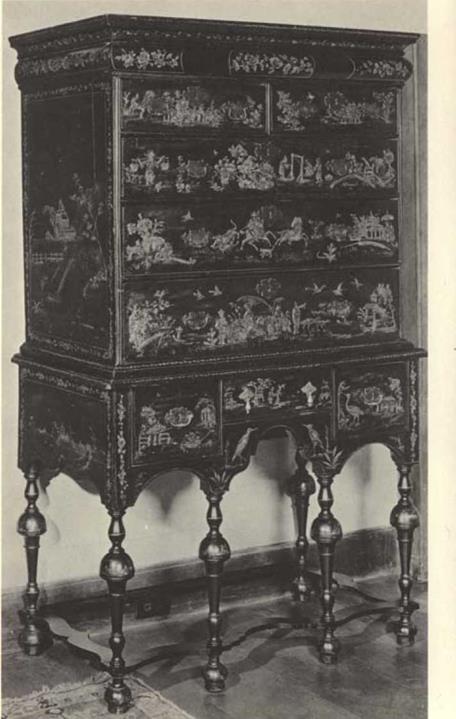
|
chair in the Bayou bend Collection {fig. 4Я), One of six (two at Bayou Bend, two at Historic Deerfield, and two in the collection of Mrs. Charles L. Bybcc and the late Charles L. Bybcc), this chair has long been listed as being decorated later in China and owned in the Winthrop-Blanchard families of Boston.[35] [36] A study of the coat of anus on the front scat rail shows that it is identical to that used by the Boston merchant Samuel Pickering Gardner (1767-1843) on his bookplate, Gardner was guardian to bis grandniece. Eliza Blanchard, after her parents died, and on March і 2, 1832, she married Robert C. Winthropd4 Thus, the family history works out’, the watermark date of 1809 on Gardner’s bookplate, together with the wedding date, provides a clue to the date of the decoration. The scenes 011 the splat have tile lustreless, stylized appearance of later decoration, and the scrolls on the stiles and legs have much in common with borders of early nineteenth-century Chinese porcelain made for the American market. The decoration was done locally, however, and the chairs did not enjoy the salt air of a trans-Pacific crossing. Other furniture was frequently redecorated in the nineteenth century by coach painters, who became the later inheritors of the japanning tradition.
Boston japanning, dien, continued for a century. Its heyday occurred during a fifty-year period preceding the Revolution, Much remains to be discovered about it. We should be 011 the lookout for tea tables and regard looking glasses with caution, since most frames wrcrc imported. They were made here, though, and japanner Stephen Whiting’s modest advertisement in tile November 12, 1767, Beston News-Letter states that he "docs more at present towards manufacturing Looking-Glasses than any one in the Province, or perhaps on die Conti-
л TT
nent.
The japanning itself should be examined carefully, since it and the fiat gilt decoration have frequently undergone overhelpful metamorphoses at the hands of later restorers and improvers. When working with documents, we should remember that furniture japanning
|
|
Dfsh and Bookcase. EngbuJ, c. 1700-1715, n. 90 inches, w, 59 inches. n, 35і/* inches. [Tin: Detroit Institute of Arts, Gift of Mrs. LcnJill Pitt;,) S«: jko fig. 47, According to family tradition, СыплютJames Bowdoln {і^гб-іудо) of Boston presented this desk and boahease to his niter Elizabeth Pins llJjftl she monied Jonathan IVamrf of Portsmouth, ityur Hampshire, ІР1 J7^j-
was only з part of a japanner s output, and that iron, tinware. and dock faces were japanned by most of them frequently. Also, in inventory listings of craftsmen’s possessions, when a japanned something is listed, that does not mean everything in the listing is japanned!
|
47. Inteitob 01 Oi:sк and Bookcam.. England. (TheDetroit Institute ofArts, Gift of Mts, Lcndall Pitts.) See also fig. 46. |
|
|
4В. Siоі Снлія, Boston. с. 1730—17*0. japanning added c. 1800-1820. Walnut and maple; 11. indies, w. 20% inches, d. 20’/a inches. (The Bayou Bend Collection of the Museum of Fine Arts, Houston.) TVris ehair was owned by Stfnrifd Pitkeriitg Gardner (1767-1^43) of Boston and later by Iris grandniece Eliza Blarirhard,
While [his article has dealt with japanning in iti strictest sense, we should not forget the early simpler painted furniture influenced by it. The so-called "Harvard” chests of eastern Massachusetts and the painted cascpicocs from the Windsor, Connecticut, area owe much to the japaliner’s art, which truly spiced many colonial homes with delicious whiffs the distant East.13
ij. See Files, Amtritim Paimtd ГнтПип, pp. 6a.
|
|
|
|
|
|
|
|
|
|
|
|
|
|


